HUGUETTE
Elated painting
Paintings and collages from the 1960’s
THAT WHICH BLOWS1…
AND IMPOSES ITSELF
Huguette Arthur Bertrand admitted to experiencing the 1950s “like a dream”,2 a decade exemplified by lively debates about the two forms of abstraction: one called “cold” and geometrical, the other “warm”, lyrical and gestural that she defended ardently. It was also a period animated by sincere friendships. Then, during the 1960s, Huguette Arthur Bertrand deployed the confidence and power of her creative gesture. She abandoned her rigid manner made of sharp streaks and adopted a black brush, free like a dance, sweeping the canvas in a lithe and vigorous movement. It is clear that she was fascinated by dynamism in space at the time. The material counted little. Diluted, the oil paint she used primarily allowed her to give structure to the composition using large coloured areas, often with warm tones such as vermilion red and orange-red: these provided the support for her lyrical impetus. Opposing forces were used. The rigour of the composition, which had always been a preoccupation for her from the start, was contrasted with a free impulse, an enflamed, exalted gesture. The artist worked on her compositions in depth and the vigour of the brush applied to the canvas made the forms move, like “movements that divide space”3 as the artist said herself. Bernard Pingaud also wrote that: “Creating a lighter stroke, softening the outlines, increasing the use of the gesture and leaving more space for blank areas all mark (…) the passage towards a way of painting which, this time, will move in depth.”4
Huguette Arthur Bertrand’s work became more powerful. Areas of tension appeared, knots of energy even formed: Migration, Nœud d’orage,5 for example, created by a brush that twirls on itself in a rotating movement.
At the heart of Huguette Arthur Bertrand’s work, the viewer travels. She guides her public around the globe with her evocative titles: Pampelune, Oulan Bator… through history and literature.
But in her work of the 1960s, the viewer above all enters into the drama, the theatrical, relating to the stage. At the meeting of elementary forces, Huguette Arthur Bertrand’s work moves, animates itself in an entirely operatic power.
It is Gounod with his Faust and Mephisto, Le Diable, and Wagner for the rampaging elements on the canvas. Her vehement titles illustrate this: Raz de Marée, Cela qui Souffle, Cela qui Gronde, Foudre, Torrent… we can almost hear the thunder rumble and the rain beating down. It is not at all surprising that her loyal friend, the art critic Michel Ragon, wrote, when describing her art: “Strong painting, painting of a dynamism that would appear masculine.”6
In fact, it was necessary to assert herself within this second generation of Lyrical Abstraction artists, born in the 1920s: François Arnal, Martin Barré, Pierre Dmitrienko, James Guitet, John Franklin Koenig, Kumi Sugaï… and some Cobra artists: Corneille and Jacques Doucet. Within this group of friends, mostly male, with whom she exhibited, Huguette Arthur Bertrand was a rare woman artist. A desire to assert her position therefore, to the point of adding a masculine first name to her signature and to truncate her birth name: “Hug” to give it authority.
Michel Ragon, a close friend, was an important ally in promoting these young artists. As early as 1950, he became their exhibition curator and favorite commentator, with Parisian museums and galleries: at the Galerie Maeght in the group exhibitions Les Mains Éblouies, at the Galerie Colette Allendy, at the Galerie La Roue…but it is above all at the Galerie Arnaud in Paris which, from 1952 was the most prominent gallery in promoting this young generation, for the annual group exhibitions called Divergences and many solo exhibitions, including several for Huguette Arthur Bertrand. In 1953, Jean-Robert Arnaud and Michel Ragon joined Roger van Gindertaël, Julien Alvard, C-H Sibert and Herta Wescher to establish an art magazine, Cimaise a favoured support and channel for defending Lyrical Abstraction.
Ten years after the 1950s, the edifying decade for lyrical non-figurative painting and for informal art, Michel Ragon reunited this generation of artists in 1967 at the Musée Galliera in Paris for the exhibition, 50-57 Une aventure de l’Art abstrait. Huguette Arthur Bertrand’s painting Fenestrée of 1954 was paired with Genghis Khan of 1966, clearly marking the young artist’s spectacular evolution.
A close friend of Michel Ragon, Huguette Arthur Bertrand also knew other of his dear friends, such as the “Lyrical trio”: Gérard Schneider, Hans Hartung, Pierre Soulages. Huguette Arthur Bertrand’s friendship was partly formed through her involvement in the album La Peau des Choses. This limited edition of poems by Michel Ragon, was illustrated with prints by his painter friends: Huguette Arthur Bertrand, Gérard Schneider, Hans Hartung, Pierre Soulages, Zao Wou-Ki, James Guitet, Victor Vasarely… and was published in 1968 by the Galerie Arnaud in honor of the twenty years of activity as a critic by their friend Michel.
Supported by recognition from her peers and a certain reputation now assured among the public from the 1950s, especially with the solo exhibition of Huguette Arthur Bertrand at the Brussels Palais des BeauxArts in 1957, her work continued to be exhibited across the Atlantic.
After a solo exhibition at the Meltzer Gallery in New York in 1956, and her participation in the group show New Talents in Europe at Alabama University in 1957, Huguette Arthur Bertrand exhibited at the Howard Wise Gallery, Cleveland a second time at the turn of the 1960s. In Paris, Huguette Arthur Bertrand also contributed to the group exhibition 50 Ans de Collage at the Musée des Arts Décoratifs in 1964.
Collage is in fact a technique that the artist would use throughout her career. While Pablo Picasso and Georges Braque used newspaper cuttings and pieces of cardboard and glued them to their paintings, during the 1960s Huguette Arthur Bertrand used rags from her studio, soaked with paint and that she attached to the support. She then turned her gaze from this ordinary object to introduce it to her artistic universe. Mixing painting and collage, forms are created, a force emanates from the composition.
Collage also appears in Huguette Arthur Bertrand’s artistic studies. In fact, if her free gesture seems totally spontaneous and improvised at first glance, it is nevertheless the result of detailed preparation in which drawings, sketches, and collages serve as a laboratory of forms, gestures, and palettes. She explained: “For me, working means first to plunge into the suspended time of creation with a quantity of drawings, washed with India ink, gouache and watercolors, little notes, finished or unfinished, some of which are only a few seeds to be sown while others are small creations. By this mass of sketches made before, during and after the work with oil, I outline the visual propositions that arise, I track the various views of a theme, and I surround myself with a vocabulary that ultimately forms a private language through which I speak to myself more and more quickly and better and better. Each picture is born from this preparatory work, seeds in this humus that is extended there.”7
With her rag collages, Huguette Arthur Bertrand explores the use of textile with a new eye. With roots in Saint-Étienne, where her grand-parents were involved in the textile industry, it was natural for her to revival this type of support. This was a first stage, before joining in a revitalization of tapestry during the next decade, following in the wake of Jean Lurçat. A new relationship with textile for this woman artist, a “new Penelope” according to the concept defined by the art critic Aline Dallier-Popper in response to a gestural painting, that is strong, but was for too long reduced to a masculine painting.
1 – Cela qui souffle, the title of a painting by Huguette Arthur Bertrand, oil on canvas, 1960 ca, 130 x 162 cm, United Kingdom, private collection
2 – Gérard Xuriguera, Les Années 50, Arted, 1984
3 – RTF/ORTF, Jean-Marie Drot and Christian Heidsieck, “L’art et les hommes”, L’œil d’un critique with Michel Ragon, programme broadcast on 4 February 1962, including an interview with Huguette Arthur Bertrand
4 – Bernard Pingaud in Huguette Arthur Bertrand, exhibition catalogue, Galerie Jacques Massol, Paris, 1964
5 – The works by Huguette Arthur Bertrand referred to here are illustrated after the text in the catalogue
6 – RTF/ORTF, ibid
7 – Huguette Arthur Bertrand, in the magazine Chefs-d’œuvre de l’Art, 1964

Huguette Arthur Bertrand,
Cela qui souffle, 1960 ca.
Oil on canvas 130 x 162 cm
Private collection, United Kingdom

Magazine Cimaise, n°4, 1959,
with a composition by Huguette Arthur Bertrand on the front cover
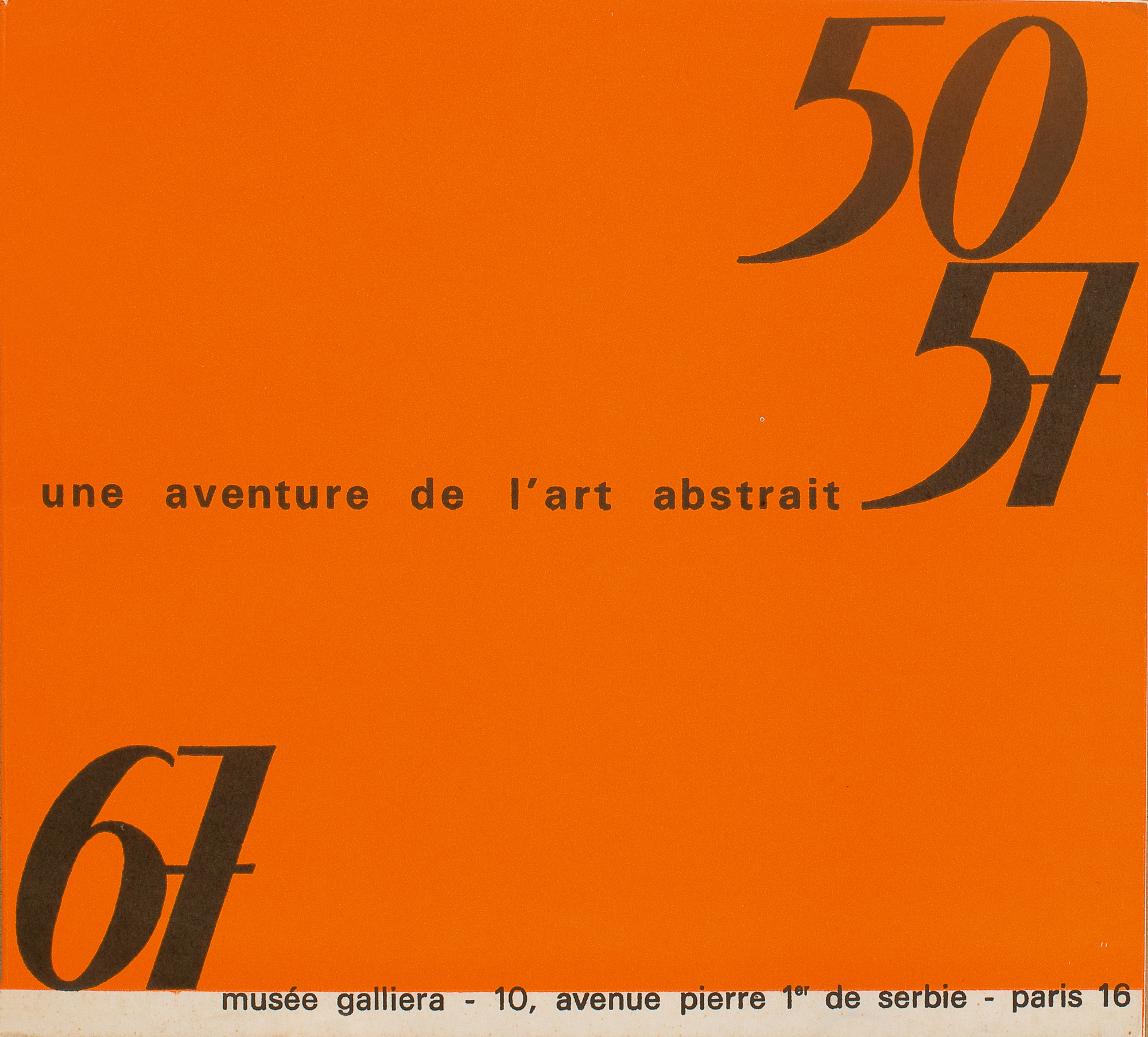
Catalogue of the exhibition 50-57
Une aventure de l’art abstrait,
Musée Galliera, Paris, 1967
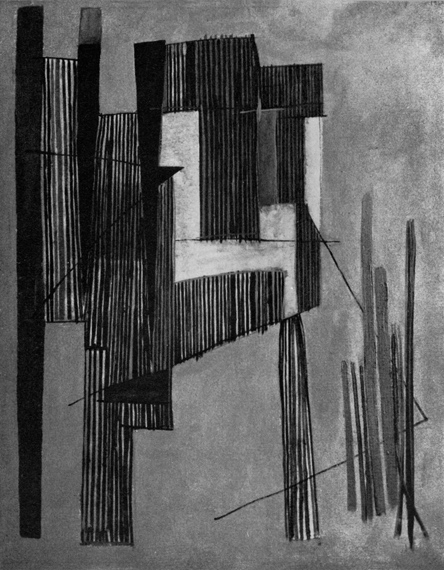
Huguette Arthur Bertrand,
Fenestrée, 1954
Oil on canvas
100 x 81 cm – 39 3/8 x 31 7/8 in.
Private collection

Huguette Arthur Bertrand
Gengis Khan, 1966
Oil on canvas
Private collection




Huguette Arthur Bertrand
Portfolio La Peau des Choses (The Skin of Things), 1968,
Jean-Robert Arnaud publisher, Paris

Gérard Schneider
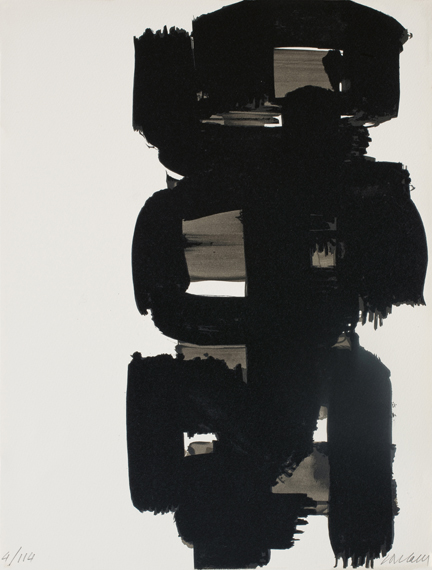
Pierre Soulages
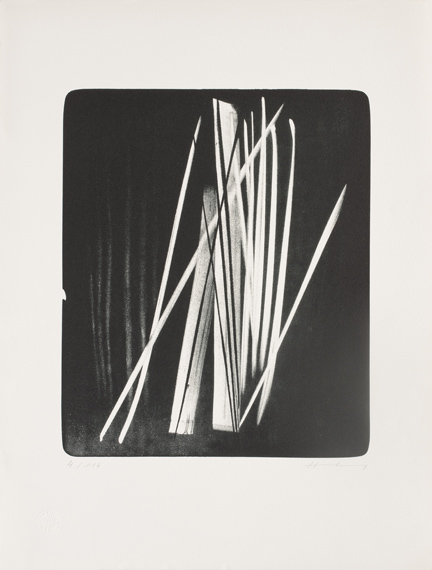
Hans Hartung

Grand collage – 1965
Gouache and rag collage on paper
110 x 75 cm – 43 5/16 x 29 1/2 in.
Signed and dated “Hug Arthur Bertrand 1965” lower left
Repr. p. 41
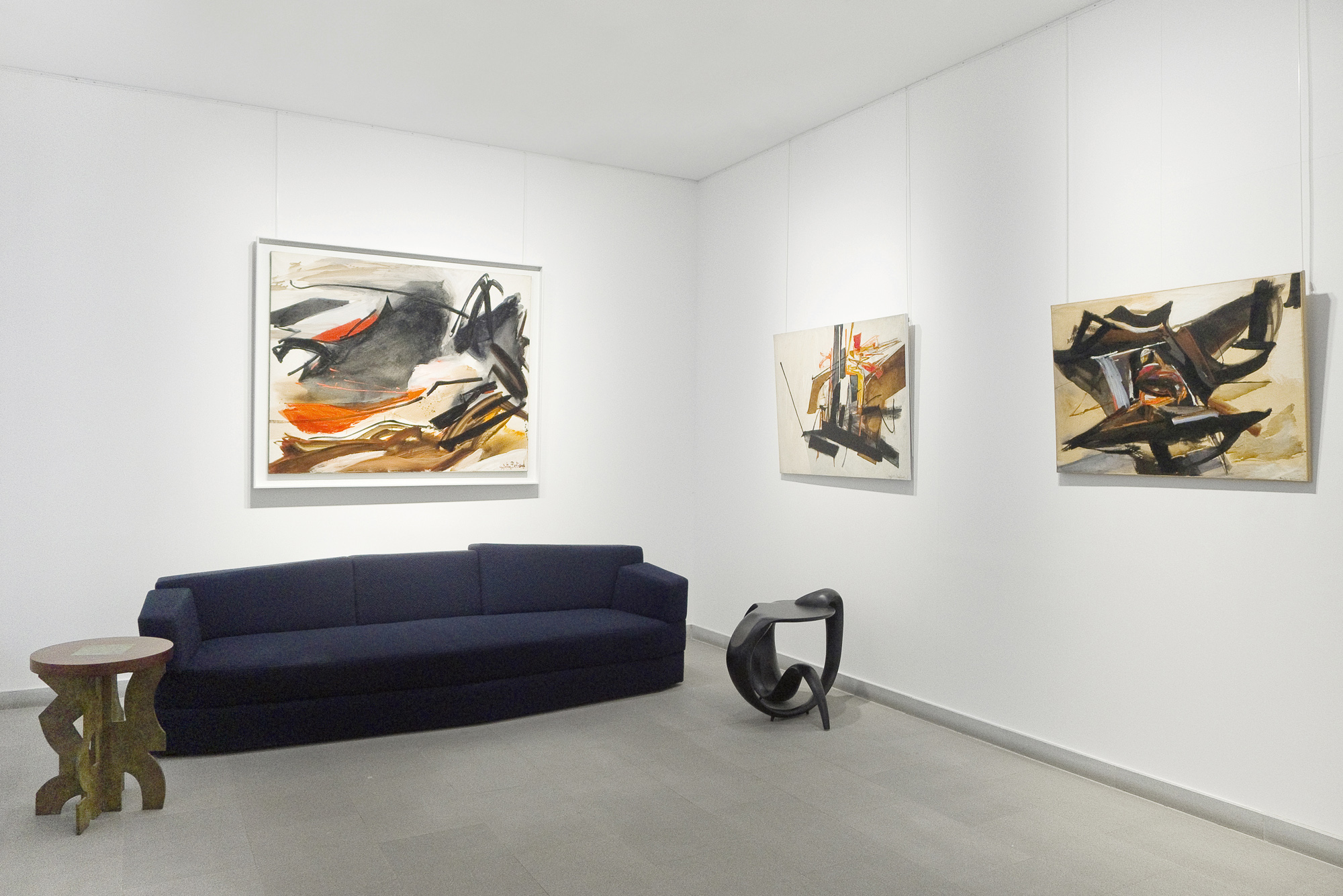
EXHIBITED WORKS
This gouache is typical of Huguette Arthur Bertrand’s work during the early 1960s.
The presence of yellow and orange show Huguette Arthur Bertrand’s preference for warm colours. The composition based around a triangle in an upward movement is also characteristic of this period during which the gesture was more obvious. Fluid brushes apply the gouache freely to create a spontaneous composition.

Untitled – 1960 ca.
Gouache on paper
22 x 17 cm – 8 11/16 x 6 11/16 in.
In the 1960s, Huguette Arthur Bertrand’s painting became more lyrical. The straight streaks were replaced by softer black brushstrokes.
In the painting Raz de Marée (Tidal Wave), Huguette Arthur Bertrand’s gesture divides the composition while shape and background start to merge. Huguette Arthur Bertrand no longer used only the contrast between the background white and the form’s colour, but started to superimpose large black brushes and flat areas of colour. In this painting, we can already imagine that colour was about to invade the entire surface of the canvas.

Raz de Marée – 1960’s
Oil on canvas
162 x 130 cm – 63 3/4 x 51 3/16 in.
Signed “Hug Arthur Bertrand” lower right; titled “Raz de Marée” on the reverse
Le tronc des Comaraves n’est pas cylindrique.
Leur forme est celle des pianos à queue, vus d’en haut.
Mais ils sont aussi élevés que des tours et sans branches.
Ils ont une telle masse de bois, franche, qui ne se dissimule pas comme font les arbres des régions tempérées, toujours prêts à devenir feuillus; assemblés par quinze ou vingt, ils forment comme des menhirs de bois.
C’est curieux ces rassemblements (presque des alignements), c’est peut-être parce qu’ils tuent autour d’eux tout ce qui vit.
Mais pourquoi ne sont-ils jamais plus de quinze ou vingt ?
Et entre eux, même pas de l’herbe, ou de la mousse ne pourrait croître, tant
ils sont affamés malgré leur air de pierre.
Le sol est lisse et sec et les insectes n’y passeraient pas — clairières, temples.
Excerpt from the poem Notes de botanique by Henri Michaux in La nuit remue, Gallimard, Paris, 1935

Comarave – 1961
Oil on canvas
89 x 116 cm – 35 1/16 x 45 11/16 in.
Signed “Hug Arthur Bertrand” lower right; dated and titled “mai-juin 1961 comarave” on reverse
Huguette Arthur Bertrand adopted abstraction definitively during the 1950s. However, their titles anchored her paintings in reality. In this way, she provided a key for understanding her works. The titles are often references to literature, but can also signify geography and nature.
Here, the title Diable (Devil) echoes the important presence of black in the composition. The title emphasizes the dramatic aspect of the work. This phenomenon can also be found in the paintings Écume Noire (Black Spume) and Gévaudan, in which the darkness is emphasized by the titles.
Diable – 1962 ca.
Oil on canvas
81 x 100 cm – 31 7/8 x 39 3/8 in.
Titled “Diable” on reverse
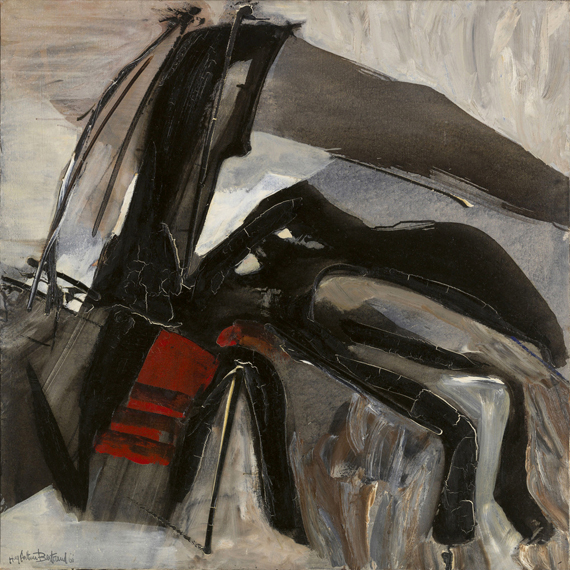
Écume noire – 1966
Oil on canvas
100 x 100 cm – 39 3/8 x 39 3/8 in.
Musée d’art moderne de Paris
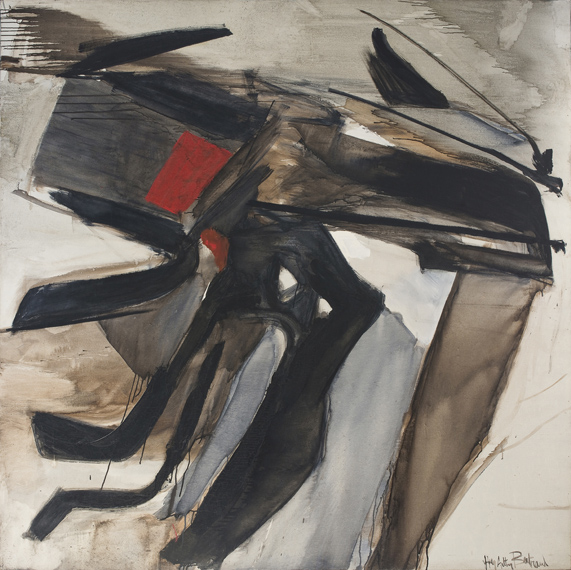
Gévaudan – 1966
Oil on canvas
200 x 200 cm – 78 ¾ x 78 ¾ in.
Private collection
Visible by appointment at the gallery
Huguette Arthur Bertrand frequently gave geographical titles to her works. She thus provided pointers in space, but also indications of the sources of her artistic inspiration.
With the painting Pampelune (Pamplona), the viewer can imagine in this abstract composition what could have impressed the artist in the city of northern Spain. Can it be understood as a tribute to its Gothic churches, a bull race, or a stage of the Camino di Santiago da Compostela?
Pampelune – 1962 ca.
Oil on canvas
81 x 100 cm – 31 7/8 x 39 3/8 in.
Titled “Pampelune” on reverse
Geography is an important aspect of Huguette Arthur Bertrand’s art. References to places, elements of nature, and meteorological phenomena, can be found in her titles.
The abelia flower evokes other pictures by Huguette Arthur Bertrand inspired by nature, such as Les Ajoncs (gorse) and Comarave. In this aspect of her work, we can compare Huguette Arthur Bertrand to artists of Abstract Landscapism such as Maria Helena Vieira da Silva, Olivier Debré and Alfred Manessier. Huguette Arthur Bertrand’s art, while being abstract, always retained a relationship with her physical environment.
Abelie – 1962-1963
Oil on canvas
116 x 89 cm – 45 11/16 x 35 1/16 in.
Titled “ABELIE” on reverse
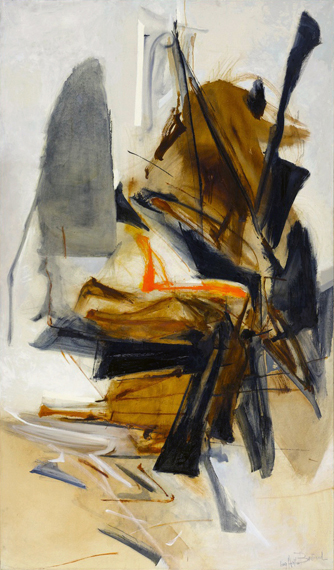
Les ajoncs – 1961
Oil on canvas
195 x 114 cm – 76 ¾ x 44 7/8 in.
Centre GeorgesPompidou, Paris
Cultural references are common in Huguette Arthur Bertrand’s work. Her titles can be inspired by literature, poetry, even opera….
Le Caporal épinglé is a novel by Jacques Perret published in 1947. It was adapted for cinema in 1962 by Jean Renoir. Huguette Arthur Bertrand’s painting, which is contemporary with the film, shows that she her sources of inspiration were varied. The story of the corporal, who was imprisoned and his various unsuccessful attempts to escape, inspired the artist who made this abstract composition from it.

Le petit caporal épinglé – 1962-1963
Oil on canvas
116 x 89 cm – 45 11/16 x 35 1/16 in.
Signed “Hug Arthur Bertrand” lower center; titled and signed “le petit caporal épinglé Hug Arthur Bertrand” on reverse; inscription “collection personnelle” on the stretcher
La terre et le bois vivent
Comme les bêtes
Mais sans bruit
Immobiles où Dieu les fit naître
Jamais ils ne sommeillent
Leurs bouches innombrables
Pompent la nourriture
Et l’eau des pluies
Plus vorace qu’un poulpe
L’étreinte du bois
Peut briser les pierres mortes
Et la terre parfois se soulève
Craque
Lorsque le soleil dessèche sa peau brune
Le bois prisonnier fait peur
Il crie la nuit un cri sec
Excerpt from a poem by Michel Ragon, in La Peau des Choses, a portfolio of prints published in limited edition by Jean-Robert Arnaud in 1968
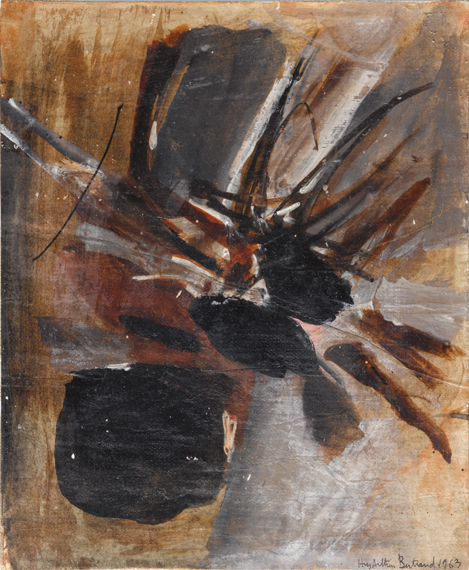
Untitled – 1963
Oil on paper laid down on canvas
21 x 18 cm – 8 1/4 x 7 1/16 in.
Signed and dated “Hug Arthur Bertrand 1963” lower right

Untitled – 1963
Oil on canvas
14 x 18 cm – 5 1/2 x 7 1/16 in.
Signed “H.ArthBertrand” lower left; dated “1963” on reverse
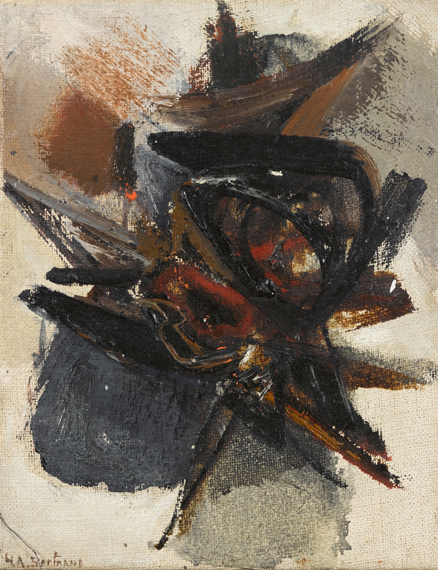
Untitled – 1963 ca.
Oil on canvas
18 x 14 cm – 7 1/16 x 5 1/2 in.
Signed “H. A. Bertrand” lower left
Huguette Arthur Bertrand used varied formats for her expression. From small canvases or sheets of paper of about 20 cm to monumental compositions covering several metres, she composed her works with great virtuosity.
These gestural works from the 1960s, with their warm colours, maintain a monumental appearance unrelated to their actual format. These two compositions, one on canvas, the other on paper, also show all the elements characteristic of this period.
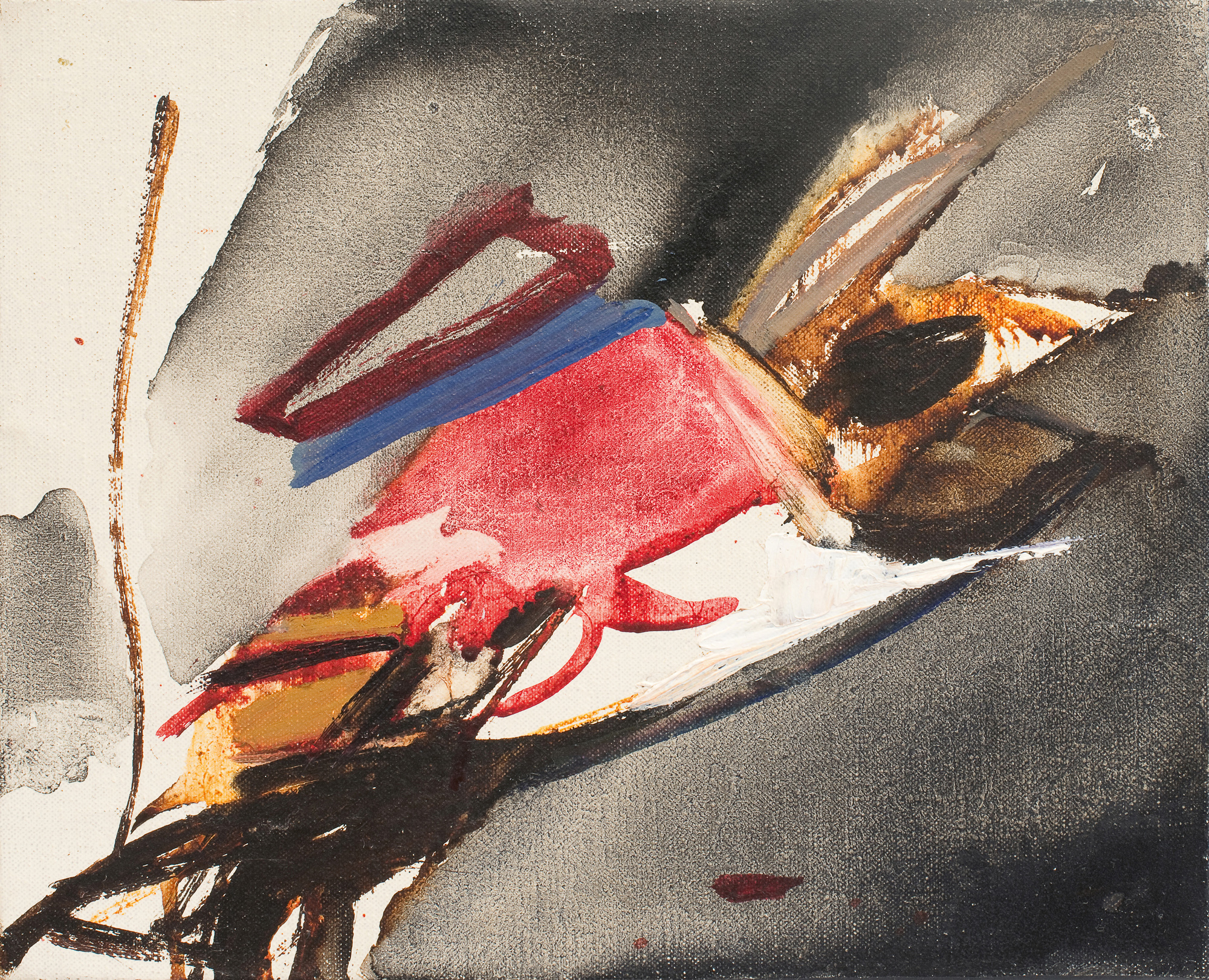
Untitled – 1966 ca.
Oil on canvas
22 x 27 cm – 8 11/16 x 10 5/8 in.
Signed “Hu Ar Bertrand” on reverse
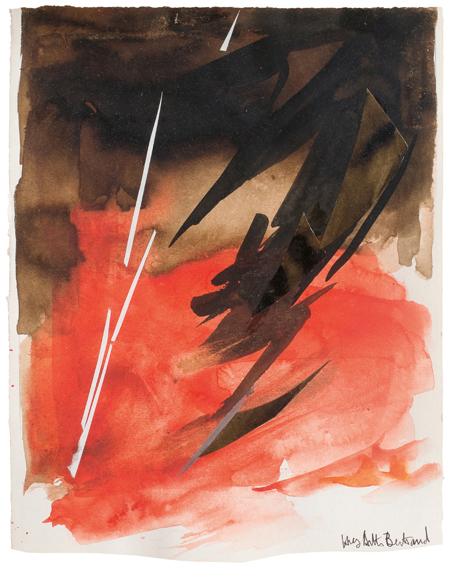
Untitled – 1960 ca.
Gouache and collage on paper
23 x 18 cm – 9 1/16 x 7 1/16 in.
Signed “Hug Arthur Bertrand“ lower right
Meteorological phenomena are a source of inspiration for the painter Huguette Arthur Bertrand. She chose them for their dramatic character: Cela qui gronde (That Which Rumbles), Torrent (Stream), Foudre (Lightning), Écume noire (Black Spume), Nœud d’Orage (Heart of a Thunderstorm)…
These titles show how important nature is to her work and also emphasize their dramatic character.

Noeud d’Orage – 1965
Oil on paper laid down on canvas
75 x 105 cm – 29 1/2 x 41 5/16 in.
Signed “Hug Arthur Bertrand” three times on front and dated “65” lower right; titled, signed and dated “Noeud d’ORAGE Hug Arthur Bertrand 1965” on reverse

Foudre – 1963
Oil on canvas
86 x 65 cm – 33 7/8 x 25 9/16 in.
Musée d’art moderne de Paris
During the 1960s, Huguette Arthur Bertrand’s painting became more and more gestural. The broad brush took over from the organized streaks of the previous decade.
Movement took on an importance in the construction of her paintings. “I wanted to invent spaces, as if moving, using the resources of painting” said Huguette Arthur Bertrand.
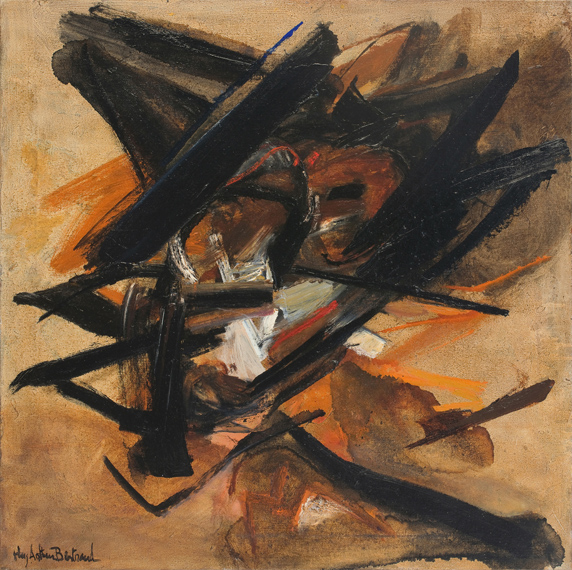
Migration – 1965
Oil on canvas
61 x 61 cm – 24 x 24 in.
Signed “Hug Arthur Bertrand” lower left; signed, titled and dated “Huguette Arthur Bertrand Migration 65” on reverse
Huguette Arthur Bertrand combined painting and cloth in collages where rags, which she had used to wipe her brushes, add form and colour to the composition. These audacious works show a desire to subscribe to a contemporary vision of textile art, between painting and object, between fine art and craft.
In Grand Collage of 1965, Huguette Arthur Bertrand superimposed brushes with black ink and rags soaked in ink or paint. This creates an organic form that stands out against a white background.
From 1971, Huguette Arthur Bertrand became interested in tapestry and was given commissions by the Mobilier National. She continued the revival of this medium that had been started by Jean Lurçat. In 1976, the art critic Aline Dallier-Popper wrote about women’s relations with textile creation and invented the term “new Penelopes” which applies perfectly to Huguette Arthur Bertrand.

Grand collage – 1965
Gouache and rag collage on paper
110 x 75 cm – 43 5/16 x 29 1/2 in.
Signed and dated “Hug Arthur Bertrand 1965” lower left
Huguette Arthur Bertrand’s painting Cela qui gronde (That which rumbles) is a perfect illustration of her art during the late 1960s.
The range of warm colours accompanies the exalted lyricism of this period. Huguette Arthur Bertrand’s painting of this period becomes more and more gestural, liberated, flexible. “They are things that fly, abstract objects that grimace, movements that divide space” said the artist.
Huguette Arthur Bertrand creates effects of materiality that oil paint allows: colour is applied in thin transparent areas and the black brush then lays down impasto that attracts the light.
Cela qui gronde – 1967
Oil on canvas
130 x 162 cm – 51 3/16 x 63 3/4 in.
Signed “Hug Arthur Bertrand” lower right; titled and dated “Cela qui gronde 1967” on reverse
The Lord said to Joshua, “I am putting into your hands Jericho, with its king and all its brave soldiers. You and your soldiers are to march around the city once a day for six days. Seven priests, each carrying a trumpet, are to go in front of the Arc of the Covenant. On the seventh day you and your soldiers are to march around the city seven times while the priests blow the trumpets. Then they are to sound one long note. As soon as you hear it, all the people are to give a loud shout, and the city walls will collapse. Then the whole army will go straight into the city.”
— Joshua 6,2-5
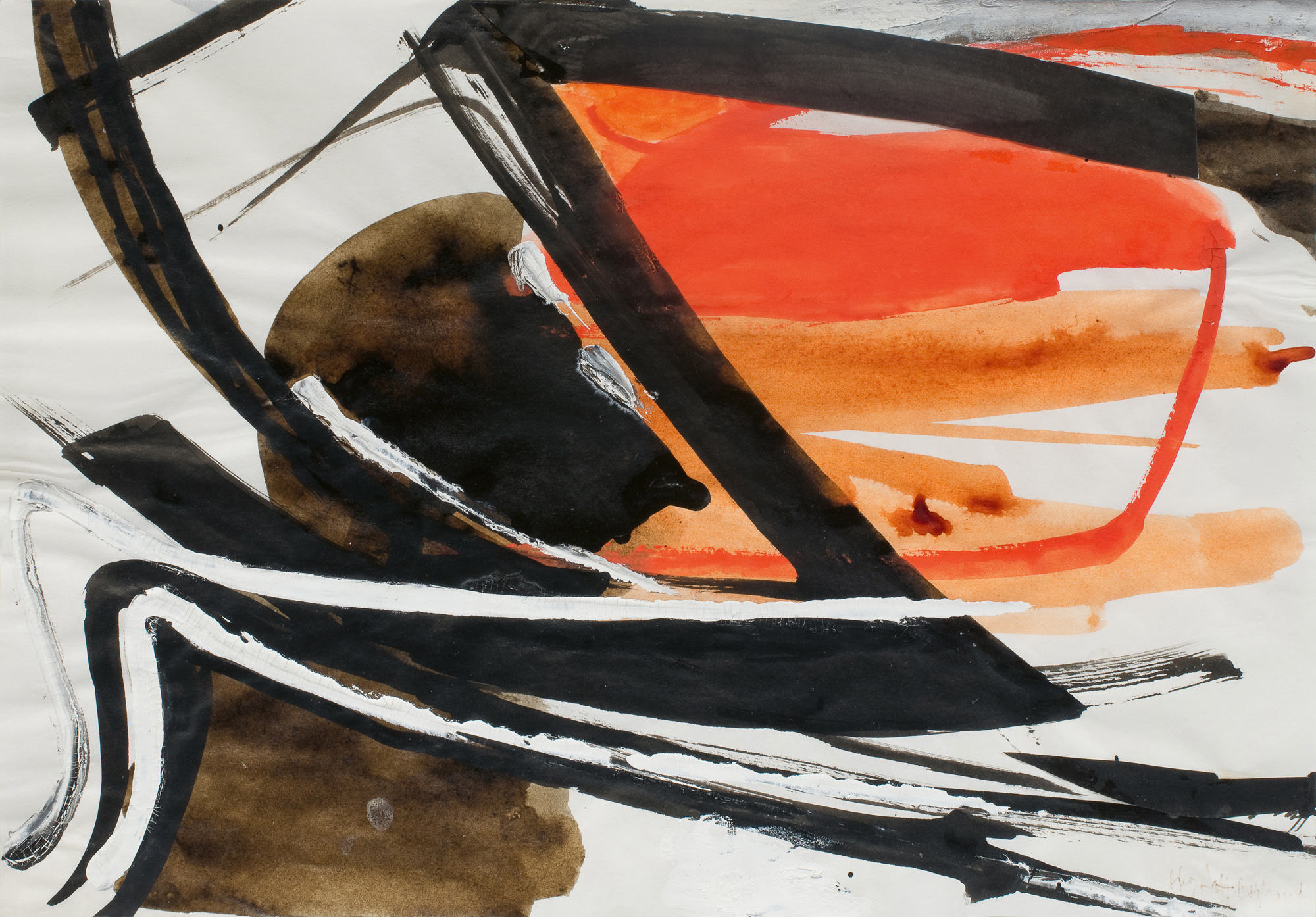
Étude pour Trompettes de Jéricho – 1969 ca.
Gouache and collage on paper
20 x 29 cm – 7 7/8 x 11 7/16 in.
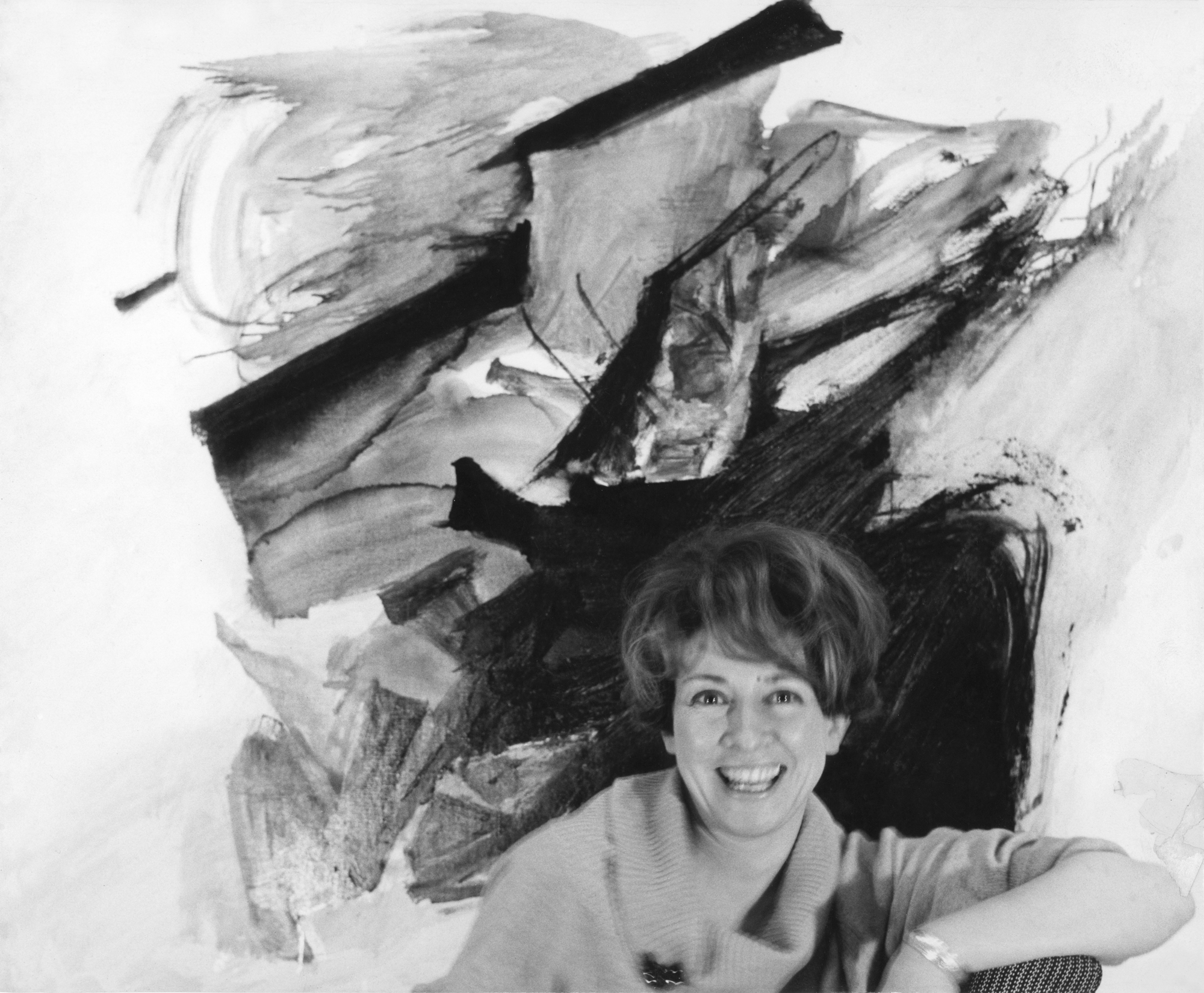
Huguette Arthur Bertrand in front of the work Tonnerre, 1964 ca.
BIOGRAPHIE
One of the few women of Lyrical Abstraction, Huguette Arthur Bertrand was an active member of the Post-War Paris art scene, rubbing shoulders with Pierre Soulages, Hans Hartung, Serge Poliakoff, Jean Dewasne, Martin Barré and Pierre Dmitrienko among many others.
A YOUNG WOMAN PAINTER IN POST-WAR PARIS
Born in 1920 in Écouen, Huguette Arthur Bertrand spent her childhood in Roanne (center south of France) and settled in Paris shortly after the war. She attended the Académie libre de la Grande Chaumière. A fellowship allowed her to spend a year in Prague between 1946 and 1947 where she had her first solo exhibition. She met the painter Joseph Sima there.
A rare painter woman in the essentially masculine artistic landscape of Post-war Paris, she immersed herself fully in the buzzing art world of Montparnasse and Saint-Germain-des-Prés. Huguette Arthur Bertrand became friendly with publishers, critics (Michel Ragon) and abstract artists, those of the Galerie Denise René: Jean Dewasne, Jean Deyrolle, Serge Poliakoff; and with Martin Barré, Pierre Dmitrienko, James Guitet, Kumi Sugaï and John F. Koenig. On Saturdays she would visit Jean-Michel Atlan’s studio with Marcelle Loubchansky. She participated with passion in this artistic effervescence, marked by lively debate between figurative and abstract art, but also between supporters of “cold” abstraction and those of “warm” abstraction: one geometric, the other gestural, lyrical, guided by a free and spontaneous gesture.
IN THE 1950’S, HUGUETTE ARTHUR BERTRAND’S SUCCESS IN PARIS
During the 1950s, Huguette Arthur Bertrand applied the full force of her art and the confidence of her artistic vocabulary made from stripes that hatch, streak, give rhythm to compositions. A powerful way of painting that confuses. A solid form of painting that marks a determined, independent character, “a type of painting that does not appear feminine at all; even muscular painting, strong, dynamic in a way that would appear masculine […]” as Michel Ragon wrote.
The woman artist Huguette Arthur Bertrand’s explosive work, which was definitively abstract from 1950, presents an audacious palette, full of colour that gradually evolved towards more dramatic shades, concentrated in a range of ochre, brown, orange-red.
In 1949 and 1950, Huguette Arthur Bertrand participated in the key exhibition Les Mains Éblouies (The Dazzled Hands) at the Galerie Maeght alongside Pierre Dmitrienko, and with Cobra artists in 1950 (Pierre Alechinsky, Corneille, Jacques Doucet).
In Paris, from the start of the 1950s, several galleries exhibited the painter woman’s work: Galerie Niepce, Galerie La Roue, Galerie Arnaud above all…
Huguette Arthur Bertrand regularly participated in the main salons of abstract art in Paris, at the Salon de Mai from 1949 until the late 1980s, at the Salon des Réalités Nouvelles until the 1990s, and at the Salon d’Automne.
The year 1955 was decisive for her: she won the famous Prix Fénéon (Fénéon award). In 1956, Huguette Arthur Bertrand participated in the Festival de l’Art d’AvantGarde, a major event held at Le Corbusier’s Cité Radieuse in Marseille, then in Nantes.
HUGUETTE ARTHUR BERTRAND’S INTERNATIONAL RECOGNITION
Her works began to travel abroad: a solo exhibition was held at the Brussels Palais des Beaux-Arts in 1957, and crossed the Atlantic: in 1956, the Meltzer Gallery in New York organized for the woman artist a solo exhibition in 1956, praised by critics, then a group show the year after: North and South Americans and Europeans. Also in 1957, the painter Huguette Arthur Bertrand participated in the exhibition New Talents in Europe at the University of Alabama. In 1958 and in 1960-61, she exhibited at the Howard Wise Gallery in Cleveland.
The works of the painter woman Huguette Arthur Bertrand continued to be exhibited in many different galleries and art events all over the world: in Germany, Austria, Belgium, the Netherlands, Denmark, England, Italy… as far as Japan, Venezuela, Mexico and Cuba.
In 1962, Jean-Marie Drot interviewed Huguette Arthur Bertrand in her studio as part of L’oeil d’un critique program, directed for French television (ORTF)..
THE WOMAN ARTIST HUGUETTE ARTHUR BERTRAND IN MICHEL RAGON’S CIRCLE OF FRIENDS
Close to the art critic, Michel Ragon, the woman artist met his circle of friends: Pierre Soulages, Hans Hartung, Gérard Schneider, Zao Wou-Ki, Victor Vasarely, among others. Together they worked on a collection La Peau des Choses (The Skin of Things), a portfolio of prints published in a limited edition by Jean-Robert Arnaud in 1968 in honour of their friend Michel Ragon.
HUGUETTE ARTHUR BERTRAND’S MATURITY WORK
Starting in 1971, Huguette Arthur Bertrand worked with tapestry for over a decade (she received commissions from the Mobilier national) and became interested in monumental mural painting. At the turn of the 1980s, her gestures became more and more liberated, and calmer, summarized in subtle white traces, airy like a breath on the canvas. The woman artist Huguette Arthur Bertrand died in 2005.
Biography by Astrid de Monteverde / © Diane de Polignac Gallery
SELECTED COLLECTIONS
Aalborg (Denmark), Museum of Modern Art
Angers, Musée Jean-Lurçat et de la tapisserie contemporaine
Dunkirk, Lieu d’Art et d’Action Contemporaine (LAAC)
Geneva, Fondation Gandur pour l’Art
Minneapolis, Walker Art Center
Nantes, Musée d’arts
Oslo, Moltzau Foundation
Paris, Musée national d’Art Moderne, Centre Georges-Pompidou
Paris, Musée d’Art Moderne de la Ville de Paris
Paris, Bibliothèque nationale
Paris, Mobilier national
Paris, Centre national d’Arts plastiques (CNAP)
Quebec, Musée des Beaux-Arts de Québec
Saint-Étienne, Musée d’Art moderne et contemporain de Saint-Étienne
SELECTED EXHIBITIONS
Les Mains éblouies (The Dazzled Hands), Galerie Maeght, Paris, 1949, 1950
Salon de Mai, Paris, 1949-late 1980s
Salon des Réalités Nouvelles, 1950-1990
Solo exhibition, Galerie Niepce, Paris, 1951
Salon d’Octobre, Paris, 1952-1953
Solo exhibitions, Galerie Arnaud, Paris,1953-1957
Wiener Secession, Vienna, 1954
Divergences, group shows, Galerie Arnaud, Paris, 1954-1957
Galerie Saint-Laurent, Brussels,1955,1956
Group show, Galerie Kleber, Paris,1955
Salon d’Automne, Lyon,1955
Éloge du Petit Format (A tribute to small format), group shows, Galerie La Roue, Paris, 1955, 1956
Salon Comparaisons, Paris,1956,1957
Galerie L’entracte, Lausanne,1956
10 Peintres de l’École de Paris, group show, Galerie de France, Paris, 1956
L’Aventure de l’Art Abstrait (Adventure of Abstract Art), group shows, Galerie Arnaud, Paris, 1956
Festival de l’Art d’avant-garde, Unité d’Habitation Le Corbusier, Marseille, 1956
Solo exhibition, Meltzer Gallery, New York, 1956
Solo exhibition, Palais des Beaux-Arts, Brussels, 1957
Biennale 57, Pavillon de Marsan, Paris, 1957
Biennale de Menton, Menton, 1957
Turin Biennale, Turin, 1957
Group show, (Expression et non-figuration, then Gouaches et collages), Galerie Le
Gendre, Paris, 1957
Festival de l’Art d’avant-garde, Unité d’Habitation Le Corbusier, Nantes, 1957
Dialogue franco-allemand, Inge Allers Galerie, Mannheim (Germany), 1957
Triennale de l’art français, Musée des Arts décoratifs, Paris, 1957
Festival de l’art d’avant-garde, Berlin, 1957
50 ans de peinture abstraite (50 years of abstract painting), group show, Galerie
Creuze, Paris, 1957
North and south Americans and Europeans, group show, Meltzer Gallery, New York, 1957
New talents in Europe, group show, Alabama University, Tuscaloosa (United States), 1957
Birch Gallery, Copenhagen, 1958
Parnass Galerie, Wuppertal (Germany), 1958
Six from Paris, group show, Galerie Howard Wise, Cleveland (United States), 1958
La Escuela de París, Museo de bellas artes, group show, Caracas (Venezuela), 1959
Peinture française contemporaine (French contemporary painting), group show,
Museums of Copenhagen, Vienna, Linz, Dortmund, 1959
Expressions d’aujourd’hui (Today’s Expressions), group show, Château de Lunéville, Lunéville (France), 1960-1961
50 peintres des Réalités Nouvelles (50 Painters of New Reality), group show, Driand Gallery, London, 1960-1961
Present day Paris painting, group show, Howard Wise Gallery, Cleveland (United
States), 1960-1961
Festival de l’Art d’Avant-garde, Pavillon américain, Porte de Versailles, 1960-1961
École de Paris (School of Paris), group show, Galerie Charpentier, Paris, 1960-1961
Solo exhibition, KK. Gallery, Copenhagen, 1962
Solo exhibitions, Galerie Argos, Nantes, 1962, 1971
Solo exhibition, Galerie Jacques Massol, Paris, 1964
50 ans de collage (50 years of collage), group show, Musée de Saint-Étienne, Saint-Étienne and Musée des Arts Décoratifs, Paris, 1964
Acquisitions récentes de la Ville de Paris (City of Paris’ Recent Acquisitions), group show, Musée d’Art moderne de la Ville de Paris, Paris, 1964
Promesses tenues (Kept Promesses), group show, Musée Galliera, Paris, 1965
L’École de Paris dans les collections au Luxembourg (School of Paris in the
Collections in Luxembourg), group show, Musée de Verviers, Verviers (Belgium), 1965
50-57, une aventure de l’art abstrait (50-57, Adventure of Abstract Art), group show, Musée Galliera, Paris, 1967
Bradford’s Print Biennale, Bradford (United Kingdom), 1968
La part des Femmes dans l’Art contemporain (Women’s part in Contemporary Art), group show, Centre Culturel d’Ivry, Ivry-sur-Seine (France), 1984
Peinture abstraite des années 1950 (Abstract Painting from the 1950s), group show,
Château de Jau, Perpignan, 1984
Charles Estienne et l’Art à Paris, 1945-1966 (Charles Estienne and Art in Paris,
1945-1966), group show, CNAP, Fondation Rothschild, Paris, 1985
Les années 50 (The 1950s), group show, Musée d’Art contemporain de Dunkirk,
Dunkirk and Musée de Besançon, Besançon, 1985
Architextures, exposition de Tapisseries (Architextures, exhibition of Tapestries), group show, École nationale supérieure des beaux-arts de Paris, Paris, 1985
Solo exhibitions, Galerie Galatée, Paris, 1987, 1990
L’art en Europe, les années décisives (Art in Europe, the decisive years), group show, Musée d’Art moderne Saint-Étienne, SaintÉtienne, 1987
Solo exhibition, Treffpunk Kunst, Saarlouis (Germany), 1988-1989
Aspects de l’Art abstrait des années 1950 (Aspects of Abstract Art in the 1950s),
traveling group show: Foyer de l’Opéra, Lille; Vieille église Saint-Vincent, Bordeaux; Auditorium Maurice Ravel, Lyon; Chapelle Saint-Louis, Rouen; Hôtel-Dieu SaintJacques, Toulouse; Musée Hébert, Grenoble; Palais de la Bourse, Nantes; Casino Municipal, Royat; Mairie de Nancy, 1988-89
Solo exhibitions, Galerie Arnoux, Paris, 1990, 2005, 2008, 2010
Solo exhibition, Maison des Arts et des Loisirs, Sochaux (France), 1991
Comparaison France-Japon (Comparing France-Japan), Grand Palais, Paris, 1992
Solo exhibitions, Galerie Olivier Nouvellet, Paris, 1992, 1993, 1997, 2008
Salon Grands et jeunes d’aujourd’hui, Paris, 1992-1995
L’École de Paris 1945-1975 (School of Paris 1945-1975), UNESCO, Paris, 1996
Les Années de combat. Le renouveau des Arts vu de Paris (The Years of Struggle. The Revival of Arts seen from Paris), group show, Galerie Arnaud and Cimaise magazine, Salle Chemellier, Angers, 1999
L’Envolée lyrique (Lyrical Flight), Paris 1945-1956, group show, Musée du Luxembourg, Paris, 200
Divergences / convergences, group show, Musée de l’Orangerie, Versailles, 2006
Réalités Nouvelles (New Reality), group show, Galerie Drouart, Paris, 2006, 2008
Huguette Arthur Bertrand, retrospective, Maison des Princes, Pérouges (France), 2007
Les Années 50 (The 1950s), group show, Banque Courtois, Toulouse, 2007
Atelier 3, Tapisseries, group show, Musée Jean-Lurçat et de la Tapisserie contemporaine, Angers, 2008
Aspect de l’Art en France 1950-1970, La Collection Allemand (Aspect of Art in France 1950-1970, Allemand’s Collection), traveling group show: Musée de Beauvais, Beauvais, 2008; Maison des Princes, Pérouges (France), 2010; Siège du Crédit Agricole, Luxembourg, Luxembourg, 2011
Les Sujets de l’abstraction, Peinture nonfigurative de la Seconde École de Paris (1946-1962), (The Subjects of Abstraction, Non figurative Painting of the Second School of Paris [1946-1962]), group show, Fondation Gandur pour l’Art, Musée Rath, Geneva, 2011
Huguette Arthur Bertrand, Donation et autres œuvres (Huguette Arthur Bertrand,
Donation and other works), Musée des Beaux-Arts, cabinet d’arts graphiques,
Angers, 2011-2012
Solo exhibition, Galerie Bertrand Trocmez, Clermont-Ferrand, 2012
Huguette Arthur Bertrand, solo show, Pavillon des Arts Décoratifs, Paris, Galerie
Diane de Polignac, 2012
Abstractions 50, l’explosion des libertés (Abstractions 50, Explosion of freedoms), Atelier Grognard, Rueil Malmaison, 2014
Abstraction Lyrique Paris 1945-1955 (Lyrical Abstraction Paris 1945-1955), Jordan National Gallery of Fine Arts, Amman, Jordan, 2014
Collection Annick et Louis Donat, town hall of the 8th arrondissement, Paris, 2015
Artapestry 3, Musée Jean-Lurçat et de la Tapisserie contemporaine, Angers, 2015
The second sex women artists in post war Paris, Hanina Gallery, London, 2018
Huguette Arthur Bertrand, Galerie Diane de Polignac, Paris, 2018
Collages hommage, Guy Resse et la Galerie La Roue, Galerie Convergence, Paris, 2019
Femmes années 1950. Au fil de l’abstraction, peinture et sculpture (Women of the
1950s. Through abstraction, painting and sculpture), group show, Musée Soulages,
Rodez, 2019-2020
Huguette Arthur Bertrand : La peinture exaltée, Peintures et collages des années 1960 (Elated painting, Paintings and collages from the 1960’s), Galerie Diane de Polignac, Paris, 2020
SELECTED BIBLIOGRAPHY
Michel Ragon, Une aventure de l’art abstrait, Paris, Laffont, 1956
Hubert Juin, Seize peintres de la Jeune École de Paris, Le Musée de Poche, Paris, Georges Fall, 1956
Michel Seuphor, Dictionnaire de la peinture abstraite, Paris, Hazan, 1957
Bernard Pingaud, Huguette Arthur Bertrand, monograph, Paris, Hoffer, 1964
Michel Seuphor and Michel Ragon, L’art abstrait, Paris, Maeght, 1973
Michel Ragon, Huguette Arthur Bertrand, followed by Notes de parcours du peintre,
monograph, Paris, Porte du Sud / Galarté, 1987
Geneviève Bonnefoi, les années fertiles, 1940-1960, Paris, Perrin, 1988
Lydia HARAMBOURG, L’école de Paris 1945-1965 : dictionnaire des peintres, Lausanne, Ides et Calendes, 1993
Patrick-Gilles PERSIN, L’Envolée lyrique Paris 1945-1956, exhib. cat., Paris, Musée du Luxembourg (April 26 – August 6, 2006), Milan, Skira, 2006
Éric de CHASSEY (dir.), Éveline NOTTER (dir.), Justine MOECKLI and other, Les sujets de l’abstraction. Peinture non-figurative de la seconde école de Paris, 1946-1962. 101 Chefsd’œuvre de la Fondation Gandur pour l’Art, exhib. cat., Geneva, Musée Rath (May 6 – August 14, 2011) / Montpellier, Musée Fabre (December 3rd, 2011 – March 25, 2012), Milan, 5 continents, 2011
Benoît DECRON (dir.), Sabrina DUBBELD, Philippe BOUCHET and other, Femmes années 1950. Au fil de l’abstraction, peinture et sculpture, exhib. cat., Rodez, Musée
Soulages (December 14, 2019 – May 10, 2020), Paris, Hazan, 2019

Diable (détail) – 1962 ca.
Repr. p. 25
Huguette Arthur Bertrand: Elated painting,
Paintings and collages from the 1960’s
Exhibition from September 10 to October16, 2020
© Textes / texts: Galerie Diane de Polignac – Astrid de Monteverde &
Mathilde Gubanski
© Droits pour les oeuvres / rights for the works: Adagp, Paris, 2020
© Traduction / translation: Jane Mac Avock
© Création graphique / graphic design: Christian Demare
© Galerie Diane de Polignac, 2020
